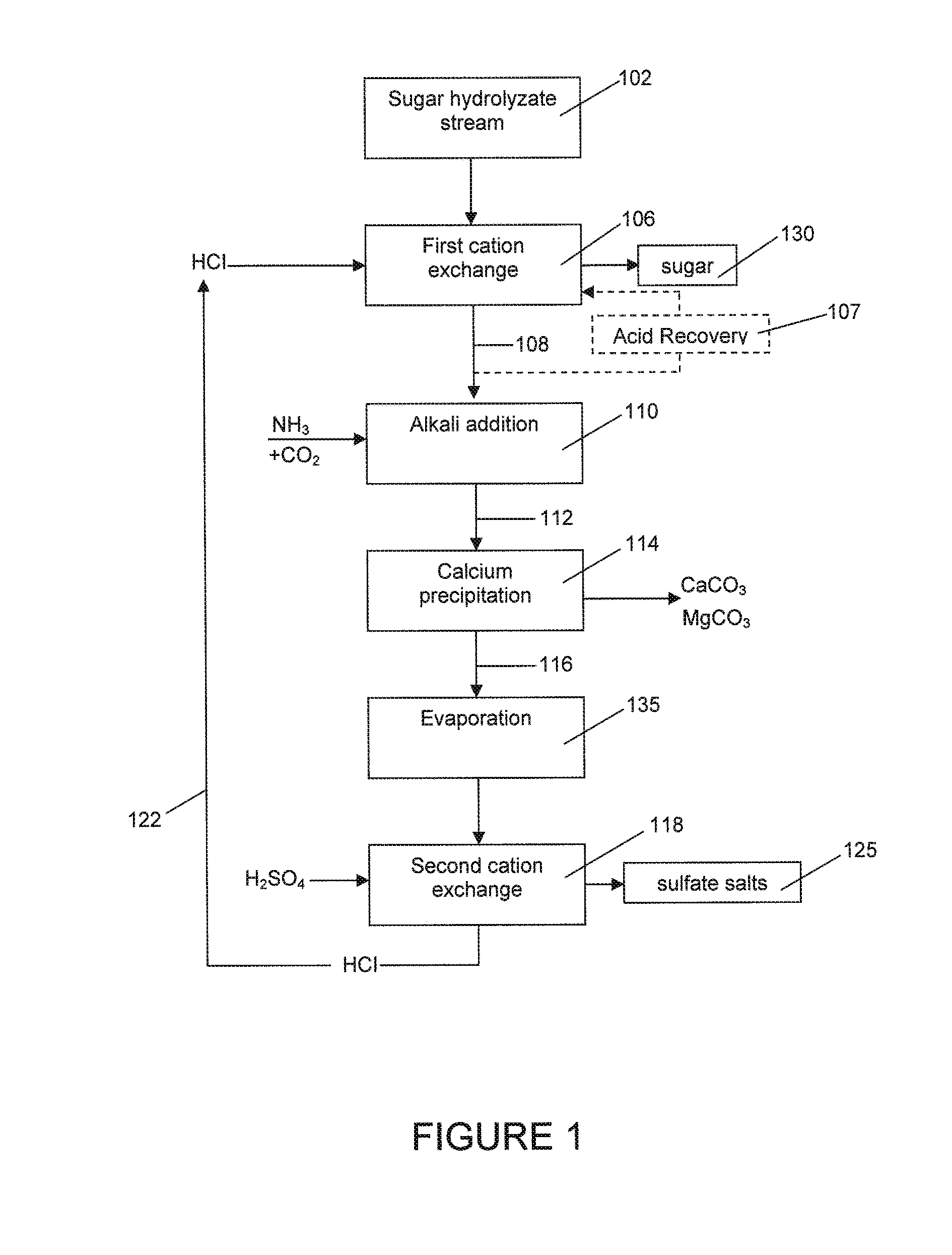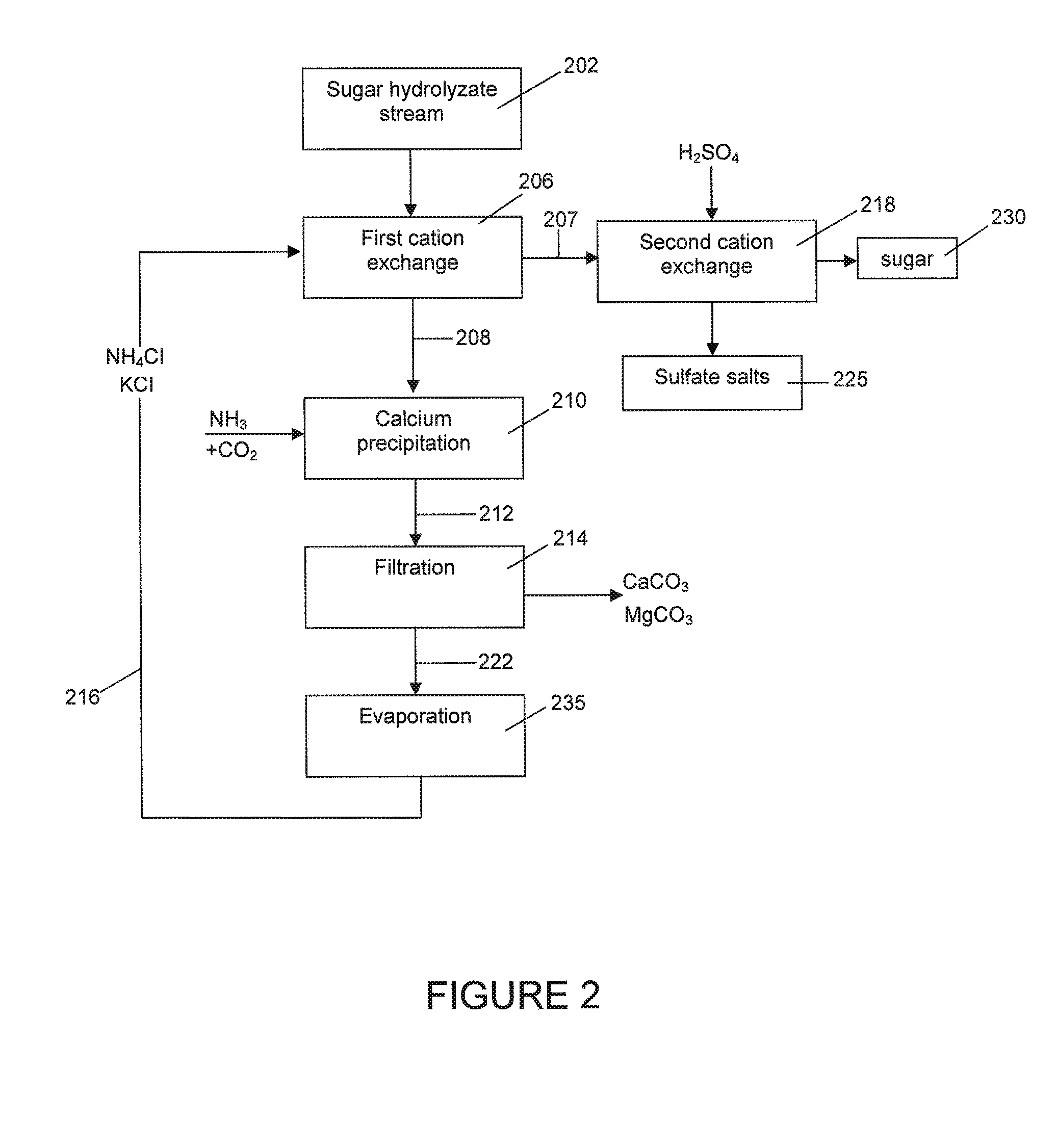Process of removing calcium and obtaining sulfate salts from an aqueous sugar solution
- Summary
- Abstract
- Description
- Claims
- Application Information
AI Technical Summary
Benefits of technology
Problems solved by technology
Method used
Image
Examples
example 1
Loading of Cation Exchange Resins with Potassium Sulfate, Magnesium Sulfate and Calcium Sulfate and Regeneration with HCl
[0202]Three solutions of potassium sulfate having concentrations of 2.11, 2.11 and 2.03 g / L K+ (referred to as runs 1, 2 and 3, respectively) were prepared and each applied to the Dowex® Monosphere® 88 resins prepared as described above. The elutions were conducted at a flow rate of 10-13 mL / min.
[0203]The results show that the potassium loading elution profiles were reproducible (See FIG. 5). The 1% breakthrough of potassium for runs 1, 2 and 3 occurred at 32.85, 33.30 and 33.74 fraction bed volumes (FBV; which is the volume of solution fed divided by the bed volume).
[0204]Three potassium-loaded resin columns fed with potassium sulfate solutions employed in runs 1, 2 and 3, respectively, were eluted co-currently with HCl. Runs 2 and 3 were eluted with 7% v / v HCl and run 1 was eluted with 3.32% v / v HCl. As shown in FIG. 6, the lower regenerant concentration in run ...
example 2
Loading of Cation Exchange Resins with Mixtures of Sulfate Salts and Regeneration with HCl
[0210]A mixture containing potassium sulfate, calcium sulfate, magnesium sulfate and sodium sulfate was prepared to examine the effect of loading a multi-component system. The concentration of Na+, K+, Mg2+ and Ca2+ in the feed to the Dowex® Monosphere® 88 resin bed was 0.08, 1.86, 0.22 and 0.50 g / L, respectively. A graph of the loading profile is shown in FIG. 11.
[0211]Columns loaded with these salts were regenerated with 7% HCl. The resin was loaded with the feed until just prior to K+ breakthrough and regenerated. Graphs of the regeneration profiles for potassium, magnesium and calcium are shown in FIGS. 12, 13 and 14, respectively.
example 3
Loading of Cation Exchange Resins with a Sugar Solution and Regeneration with HCl
[0212]Wheat straw was pretreated at 185° C., pH 1.0 with 1 wt % sulfuric acid in a manner consistent with the description in Foody, U.S. Pat. No. 4,461,648. After pretreatment, the straw was washed with water to produce a sugar solution. The non-neutralized sugar solution was doped with calcium, magnesium and potassium sulfate salts, as well as xylose, sulfuric acid and acetic acid to obtain target concentrations for each of these components. Target concentrations for Ca2+, Mg2+, Na+ and K+ were 0.59 g / L, 0.23 g / L, 0.05 g / L and 1.89 g / L, respectively and target concentrations for sulfuric acid, acetic acid and xylose were 8.28 g / L, 6.52 g / L and 49 g / L, respectively.
[0213]The sugar solution was fed to a Dowex® Monosphere® 88 resin bed prepared as described previously. The elution profiles of K+, Ca2+, Mg2+, sulfate, acetate, glucose and xylose in the sugar solution is shown in FIG. 15. The order of catio...
PUM
| Property | Measurement | Unit |
|---|---|---|
| Solubility (mass) | aaaaa | aaaaa |
| Cation exchange capacity (equivalent) | aaaaa | aaaaa |
| Precipitation enthalpy | aaaaa | aaaaa |
Abstract
Description
Claims
Application Information
 Login to View More
Login to View More - R&D
- Intellectual Property
- Life Sciences
- Materials
- Tech Scout
- Unparalleled Data Quality
- Higher Quality Content
- 60% Fewer Hallucinations
Browse by: Latest US Patents, China's latest patents, Technical Efficacy Thesaurus, Application Domain, Technology Topic, Popular Technical Reports.
© 2025 PatSnap. All rights reserved.Legal|Privacy policy|Modern Slavery Act Transparency Statement|Sitemap|About US| Contact US: help@patsnap.com



